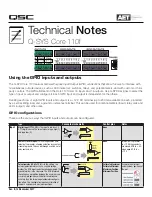
The Multifunction card
2 - 6 • • • Senstar 100 Installation guide
The Multifunction card
The Senstar 100 Multifunction card (MFC) can be installed in any PCI slot on the
motherboard. It includes an interface card that provides access to the second
serial port, and to four dry contact relay outputs (O/Ps).
illustrates the MFC, and
illustrates the interface
card. The interface card connects to the MFC via two 20 cm (8 in.) ribbon cables
and requires a vacant rear panel slot (but no motherboard slot) for installation.
The MFC provides the Senstar 100 system with four distinct functions:
•
watchdog (sanity) timer
•
serial interfaces (two EIA-232 ports)
•
two external control O/Ps
•
four dry contact relay O/Ps
Features
The MFC includes the following:
•
watchdog (sanity) timer circuitry, to automatically reboot the Senstar 100
system via the power reset harness if a failure occurs
•
two fully populated EIA-232 serial communication ports with DB-9 male
connectors, for the connection of primary devices
•
two open collector active low alarm O/Ps via an RJ11 4-pin modular
telephone plug (J9), which includes power (pin 1) and ground (pin 4)
connections for external alarm reporting, or to drive an automatic serial
switching chassis
•
pin 2 provides Senstar 100 display alarm annunciation (100 ms pulsed
O/P for remote or alternate audio alert)
•
pin 3 provides the Senstar 100 ready signal (O/P is low when the Senstar
100 operates normally; otherwise, the O/P goes high)
•
a 3.5 mm mono speaker plug (J8), to connect an amplified PC-type speaker
for external alarm and touch input reporting (450 Hz and 1850 Hz audio
tones)
•
four dry contact relay outputs (normally open [N.O.] and normally closed
[N.C.]), to enable control of other devices locally (no surge protection)
(N.O./N.C. form C relay O/Ps 30 V, 1 A max.)
•
no interrupt jumpers or address switch settings required - the PCI version
Multifunction card address and interrupts are assigned automatically by the
computer BIOS
















































